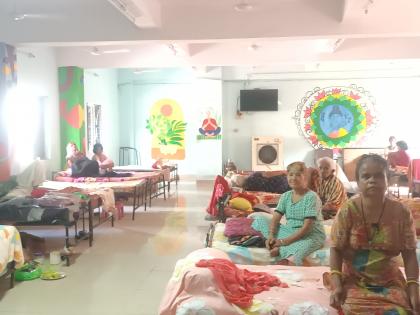NMC Helps Homeless Women in Nagpur
By Lokmat English Desk | Updated: May 29, 2024 12:40 IST2024-05-29T12:39:20+5:302024-05-29T12:40:12+5:30
Zainab Saifee, Lokmat News Network (Nagpur) Summer has largely remained unpredictable this year. The season has seen the ...

NMC Helps Homeless Women in Nagpur
Zainab Saifee, Lokmat News Network (Nagpur)
Summer has largely remained unpredictable this year. The season has seen the weather oscillating between extreme heat and humidity to rains and thunderstorms leaving most perplexed. At the fag end now and with the mercury rising to 44 degree celsius and above, people look for every bit of shade that they can find to protect themselves from an unforgiving sun. Imagine, thus, the plight of the 'homeless' who have nowhere to go and no one who would care!
These are destitutes who beg outside places of worship and other spots frequented by the better off or just lie on street corners, impoverished and unsheltered. Some are native to the region while others were meant to be migrants but were stuck here by some strange quirk of fate.
The social welfare department of Nagpur Municipal Corporation (NMC) does its bit along with the social service team of the city police. Drives have been organised under the guidance of NMC's deputy commissioner Ranjana Lade to provide shelter to the homeless. There are five shelter homes and one beggar home in the city run by NGOs for people above the age of 18 years. They conduct drives all year round but intensify them during summers and winters.
As part of the "Heat Action Plan", the drive started on April 4 and has till now rescued 106 homeless people. These shelter homes have a capacity to accommodate 430 people and 355 people are presently living there. Only one houses women with a capacity of 25 which presently has one additional occupant. When asked about plans to increase the number of shelter homes, Dr. Ranjana admitted to there being a "space constraint in expansion.”
NMC provides food for 10 per cent of the people who are above 60 years of age in these shelter homes. But since it is difficult for women to sustain themselves, their food is sourced through NGOs or social activists. But for people living in beggar homes, three meals are provided and in some cases, beggars’ children are also accommodated. In the last two years, Aastha Beggar Relief Homes have brought 594 people into the mainstream through employment, reuniting them with families, or by shifting them to old age homes or the mental hospital.
“There should be more shelter homes, especially for women, because even after we run full, there are still many people left on the roads,” says Priti Indorkar, caretaker of Bodhisattva shelter for the homeless. “We always keep two beds vacant for emergency cases,” she adds.
With seepage on one wall and a washroom of at least one room in a deplorable condition, the shelter houses 20 people. Authorities provide bedsheets, sanitary products, and newspapers to them. The salary for the manager, three caretakers, cook, and cleaners is also funded through the NGO. However, the salaries of the manager and caretakers are reimbursed by the NMC in two to three months.
“We have to counsel the inmates a lot, they don’t like to stay here because they don’t have access to alcohol or smoking,” says Priti. “Many people come to the street after a fight at home or they sleep on the road after being drunk. Police bring them here without asking them about their whereabouts and after counseling they reveal their identity, give phone numbers, and then, we reunite them with their families,” she revealed.
The major problem behind poverty and homelessness is the lack of proper education and employment opportunities and on top of it. Alcoholism only increases the problem. Fights among families are also due to employment issues.
Right opposite the Bodhisattva Shelter Home is the Aapulki Urban Shelter for the Homeless which has a capacity of 50 people. “We counsel them for six months and encourage them to work and have a reputable life in the community. While some understand, some still relapse into drinking,” says the manager.
Nilima Jangam, the caretaker of Aadhar Urban Homeless Shelter in Sitabuldi says, “they are usually scared and try to run away, but we have to calmly explain to them, bring them to the shelter, and see if they are eligible to work.” This is the only one that houses women and is already running full.
In one hall with multiple beds, several fans, and one cooler, older women and women with a mental disability reside in the homeless shelters. The hall for men is located below. “We only lodge people who are above 18 years of age and usually take them from public places” adds Nilima. “There are cases when women live off on the street after an altercation with the family, but we find their family members, verify it, and send them back.”
Shelter homes provide health care facilities, provision to make Aadhar cards, and other documents, open bank accounts, and also admit them to rehabilitation services. On October 10, they observe “Homeless People Day,” when inmates are taken for an outing.